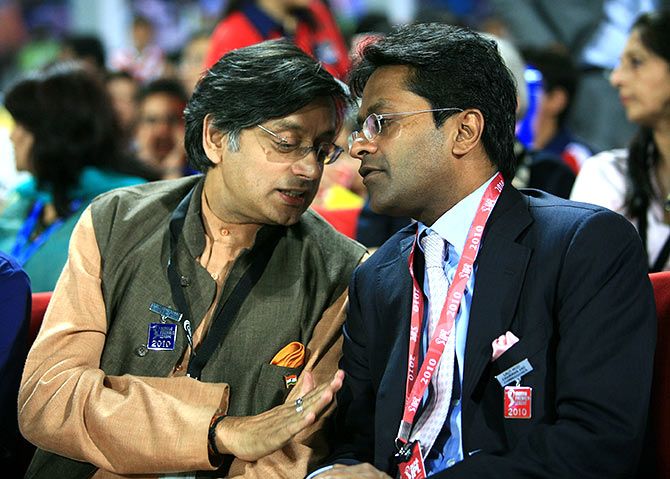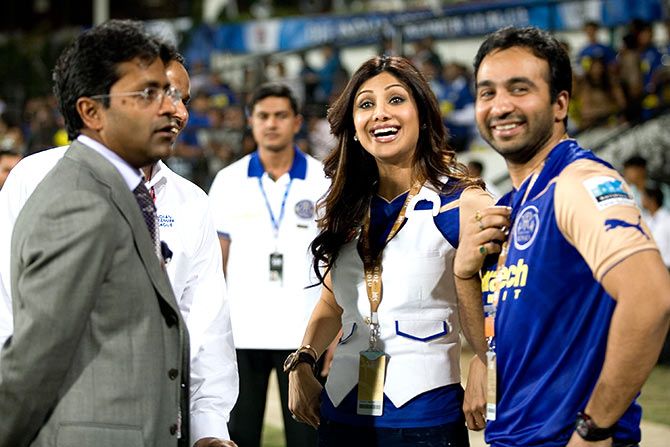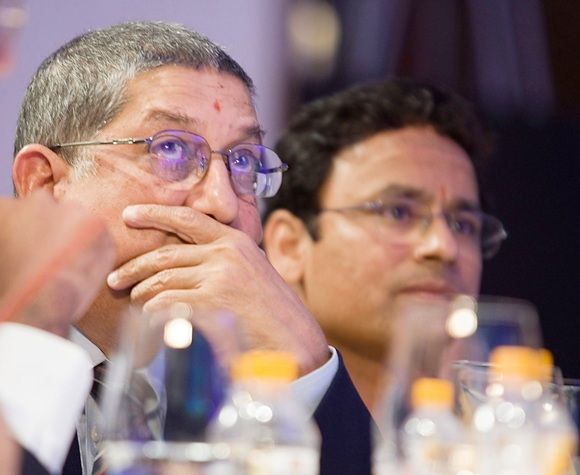The IPL has produced more controversies in its short lifespan than any other sporting league in history, says legendary cricket writer Prem Panicker.

The Indian Premier League is a strange beast.
It came along at a time when cricket needed reinvention; it captured the imagination by whisking cricket and showbiz in a blender set on high to produce a heady cocktail of on- and off-field entertainment that put butts back in the seats; it provided a highly visible platform and a viable livelihood for young talent that until then had been condemned to the stultifying obscurity of the domestic season; it lined the pockets of former internationals who had played the game before big money entered cricket; and it more than doubled the BCCI's annual revenues overnight.
However, the IPL simultaneously shredded whatever remained of our collective cricketing innocence and ensured that we would never again be able to watch seemingly commonplace acts -- a player walking out with an odd-colored grip on his bat, a bowler adjusting the towel tucked in his waistband, wiping the sweat off his eyes or pausing in his run-up to tie his shoelaces -- without instinctively suspecting the integrity of what is to follow.
The league dragged cricket off the playing fields and onto the front pages of the media, and into courtrooms across the land in a way that is unprecedented even in the BCCI's troubled history.
Non-trivial fact: In the financial year 2009-2010, the board spent a total of Rs 245,311,974 on lawyers' fees alone -- a sum that does not take into account the amounts spent by its various opponents. Note that this was before N Srinivasan's serial troubles roiled the sport and forced him and sundry other BCCI officials to spend more time in courthouses than in their offices.
Back in 1968, Andy Warhol summed up the dawning age of saturation TV coverage, and with remarkable prescience foreshadowed our own era of social media immersion, when he said that 'In the future, everyone will be world famous for 15 minutes.' He left the corollary unstated -- that in this same attention-deficit age, infamy too will have as brief a shelf-life.
Thus, while the subtext of the ongoing edition of the IPL is the suspension of two key franchises, we've long lost sight of the fact that every edition of the league, beginning with the first, has been marred by controversy.

The inaugural season (2008) featured recurring questions about the opacity of team ownership, with particular reference to the three franchises IPL founder Lalit Modi was linked to. That was also the year when stories of dark doings at the glitzy after-parties began making the rounds.
2009 featured the abrupt change in venue from India to South Africa and consequent financial irregularities that are still being probed, in desultory fashion, by various government agencies.
The third season (2010) saw the drama around the Kochi Tuskers franchise and introduced us to the concept of 'sweat equity'; it triggered Modi's exile and derailed Shashi Tharoor's rise within the Congress hierarchy. The season also witnessed drama around the BCCI's ultimately abortive attempt to terminate the Rajasthan and Punjab franchises.
Season four (2011) saw the termination of the Kochi franchise, amid mounting suspicion that funny money had found its way into the league. 2012 saw the exit of Deccan Chargers, the entry of the scam-tainted Marans of Tamil Nadu via the Sunrisers franchise and the first whiff of on-field shenanigans when five players -- T P Sudhindra (Hyderabad), Mohnish Mishra (Pune), Amit Yadav and Shalabh Srivastava (Punjab), and the unattached Abhinav Bali -- were trapped by a television sting operation, and subsequently suspended.
Season six (2013) was the IPL's annus horribilis, with players (S Sreesanth, Ankit Chavan and Ajit Chandila), umpires (Asad Rauf) and team principals (Gurunath Meyyappan of Chennai and Raj Kundra of Rajasthan) making the front pages over spot-fixing and/or gambling charges. In the process, the spotlight intensified on the BCCI's capo di tutti capi, N Srinivasan.
Season seven (2014) was the year the Supreme Court was 'nauseated' by the affairs of the board and its reigning boss and began an activist intervention that continues to hog headlines to this day. It was also the year that saw the Mukul Mudgal committee hand over to the Supreme Court a sealed envelope containing 13 names of people suspected of various acts of malfeasance.
Four of those names are known, but eight unrevealed names continue to hang over the sport -- a ticking bomb that will sooner than later explode, with potentially devastating consequences.
And season eight (2015) enshrined 'conflict of interest' in our working vocabulary, and its aftermath saw the suspension, at year-end, of two high profile franchises.
The list omits a few relatively minor controversies along the way -- think, for instance, of the several instances of manipulated player auctions and the persistent buzz of off-the-books payments to leading players, with all that this implies from the point of view of wholesale corruption.
But it does prove the central point: That the IPL has produced more controversies in its short lifespan than any other sporting league in history.
Crucially, the list underlines the fundamental problem of the ADD era: our social media-fuelled addiction to the outrage of the day ensures that we rapidly forget the events of even the immediate past.
Consequently, our histories repeat, 'first as tragedy, then as farce.'

Two recent books come as antidotes to this mass amnesia: Fixed: Cash and Corruption in Cricket by Shantanu Guha Ray and Not Out: The Incredible Story of the Indian Premier League by Desh Gaurav Sekhri. Both are united by the central themes of cricket and corruption, yet each takes a markedly different approach to the subject.
Guha Ray goes beyond the IPL to examine corruption in cricket overall. His intent is to document, and he fulfils that brief across 14 chapters, each examining one central event.
The operative part of the book begins on March 17, 2007 and the death under strange circumstances of then Pakistan coach Bob Woolmer; it goes on to explore the Jekyll and Hyde career and mysterious death of disgraced South African captain Hansie Cronje; the 2011 spot-fixing scandal involving Salman Butt, Mohammed Asif and Mohammed Amir; the backstage controversies that mired the Kochi Tuskers franchise and led to the exile of Lalit Modi; the issues surrounding the 2012 life ban imposed on leg spinner Danish Kaneria; the Bangladesh Premier League sex-and-spot fixing scandal of 2005 that resulted in the exit of Mohammed Ashraful, and the cloud of suspicion that still hangs heavy over the March 20, 2011 World Cup game between India and Pakistan in Mohali.
The narrative surrounding each incident is backed by considerable research, of the kind you would expect from someone who earned his chops as an investigative journalist. Collectively, these chapters -- and others detailing the modus operandi of the bookmaking fraternity, the 2011 controversy that pitted the BCCI against Neo Sports, the rise and decline of Lalit Modi, and a (mildly hagiographic) chapter on the late Jagmohan Dalmiya -- serve as a handy aide memoire to plug the gaps in our sieve-like memory.
Each of these stories has made headlines for a day, but when you collect them together in one place, as Guha Ray does, the dots begin to connect up, larger patterns emerge, and our understanding of the many ills plaguing the sport deepens beyond the here and the now.
Desh Gaurav Sekhri's book is the polar opposite, in both theme and treatment. Sekhri fixes his focus firmly on the IPL to the exclusion of all else, and his approach is a mix of the documentary and the prescriptive.
He establishes his intent early on, when he makes the point that the IPL -- thanks to its early mover advantage, its massive captive audience, and its ability to mix India's two main social preoccupations, celebrity and cricket, into an addictive cocktail -- was uniquely positioned to be cricket's game-changer.
That early promise, Sekhri argues, was nullified by the BCCI's many sins of omission and commission, which have systematically downgraded the appeal of the league, permitted the rise of several rivals, and decimated the actual -- as opposed to notional -- value of each individual franchise.
Basing the book on that premise, Sekhri breaks the IPL story down into its component parts: The structure of the league; the mechanics of player auctions; the serial controversies around egregious conflicts of interests; and the BCCI's insistence on 'control', that has led to a steady erosion in the value of individual franchises. Each chapter fleshes out its central premise with facts and figures, and examines possible solutions to the problem.
The IPL and its plethora of issues are grist for everyday conversation, and -- such is the nature of the 140-character ecosystem -- each fresh controversy is analyzed, and a solution prescribed, in the space of two tweets.
Mismanagement? Sack Rajeev Shukla and ban all politicians.
Corruption? Send the offenders to jail.
Allied to our 'off with his head' notion of crime and punishment is outrage -- why is a Sreesanth contesting elections when he should be in prison? Who is shielding the guilty? BJP gave him a ticket! No wait, his corruption dates to the UPA tenure!!
Therein lies the fundamental problem: We fans, who skip nimbly from headline to outrage, and a media intent on fuelling our ire, have created a situation where systematic reportage and analysis is lacking.
Absent this, there is anger sans insight; there is a collective disillusionment with what exists, but no informed sense of how we got here, and how this can be turned around.
It is here that Sekhri's book is most valuable. He brings to his narrative the skill sets of day job as a lawyer specialising in sport; his reportage is firmly grounded in a granular understanding of the laws of the land, and his suggestions are informed by his knowledge of what is possible, and what is not, within the legal framework.
Of particular interest is his dissection of how the IPL is a league merely in name and not in structure, and how this needs to be corrected in order to create lasting value for the franchises and therefore to the league itself.
Equally worth study is his recasting of the player auction by applying the principles of the player draft that is in vogue with the world's best sporting leagues, and his recommendations on the need to reframe the laws in order to legalise gambling.
Also worth noting is Sekhri's extensive thoughts on the IPL's need to reframe its governance structure and to introduce the office of an empowered commissioner, in much the same way organised baseball refurbished its image by handing over the keys to Judge Kenesaw Landis in the wake of the 1919 Red Sox fixing scandal.
Sekhri's informed suggestions nod in the direction of, and build on, the recommendations submitted to the Supreme Court by the Justice Lodha Commission, and provide both context and nuance needed to better understand the ongoing court proceedings.
Like it or no, the off-field issues surrounding cricket have ensured that its impact has spilled over from the field, and today challenges our core values, both from an individual standpoint and as a nation.
If we must spent so much time talking about it -- and if our courts need to spend so much time trying to bring order to chaos -- then the least we can do is first understand the many issues surrounding the sport.
And it is for this reason that these two books -- along with James Astill's The Great Tamasha and Bookie, Gambler, Fixer, Spy by Ed Hawkins -- are useful, timely additions to the canon.








